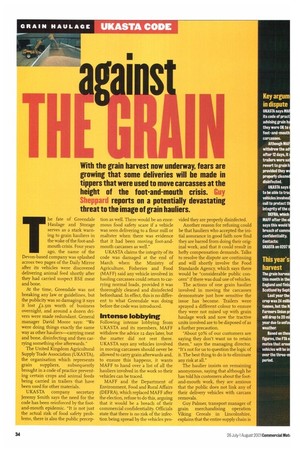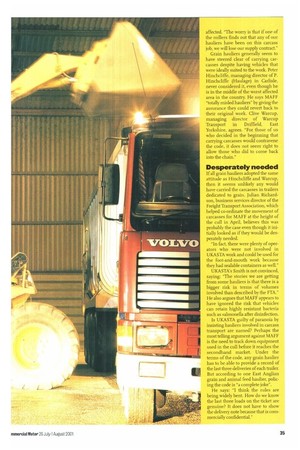With the grain harvest now underway, fears are growing that
Page 34

Page 35

If you've noticed an error in this article please click here to report it so we can fix it.
some deliveries will be made in tippers that were used to move carcasses at the height of the foot-and-mouth crisis.
ShepparP reports on a potentially devastating threat to the image of grain hauliers.
The fate of Greendale Haulage and Storage serves as a stark warning to grain hauliers in the wake of the foot-andmouth crisis. Four years ago, the name of the Devon-based company was splashed across two pages of the Daily Mirror after its vehicles were discovered delivering animal feed shortly after they had carried suspect BS E meat and bone.
At the time, Greendale was not breaking any law or guidelines, but the publicity was so damaging it says it lost £2.5m worth of business overnight, and around a dozen drivers were made redundant. General manager David Moore says: "We were doing things exactly the same way as other hauliers—carrying meat and bone, disinfecting and then carrying something else afterwards."
The United Kingdom Agricultural Supply Trade Association (UKASTA), the organisation which represents grain suppliers, subsequently brought in a code of practice preventing certain crops and animal feeds being carried in trailers that have been used for other materials.
UKASTA company secretary Jeremy Smith says the need for the code has been reinforced by the footand-mouth epidemic. "It is not just the actual risk of food safety problems, there is also the public percep tion as well. There would be an enormous food safety scare if a vehicle was seen delivering to a flour mill or maltster when there was evidence that it had been moving foot-andmouth carcasses as well."
UKASTA claims the integrity of its code was damaged at the end of March when the Ministry of Agriculture, Fisheries and Food (MAFF) said any vehicle involved in hauling carcasses could return to carrying normal loads, provided it was thoroughly cleaned and disinfected beforehand. In effect, this is no different to what Greendale was doing before the code was introduced.
Intense lobbying
Following intense lobbying from UKASTA and its members, MAFF withdrew the advice 12 days later, but the matter did not rest there. UKASTA says any vehicles involved in moving carcasses should never be allowed to carry grain afterwards and, to ensure this happens, it wants MAFF to hand over a list of all the hauliers involved in the work so their vehicles can be traced.
MAFF and the Department of Environment, Food and Rural Affairs (DEFRA), which replaced MAFF after the election, refuse to do this, arguing that it would be a breach of their commercial confidentiality. Officials state that there is no risk of the infection being spread by the vehicles pro vided they are properly disinfected.
Another reason for refusing could be that hauliers who accepted the initial assurance in good faith now find they are barred from doing their original work, and that it could result in hefty compensation demands. Talks to resolve the dispute are continuing and will shortly involve the Food Standards Agency, which says there would be "considerable public concern" if there was dual use of vehicles.
The actions of one grain haulier involved in moving the carcasses demonstrate just how sensitive the issue has become. Trailers were sprayed a different colour to ensure they were not mixed up with grain haulage work and now the tractive units involved are to be disposed of as a further precaution.
"About 50% of our customers are saying they don't want us to retain them," says the managing director. "It's not for us to question the logic of it The best thing to do is to eliminate any risk at all."
The haulier insists on remaining anonymous, saying that although he has told his customers about the footand-mouth work, they are anxious that the public does not link any of their delivery vehicles with carcass removals.
Guy Palmer, transport manager of grain merchandising operation Viking Cereals in Lincolnshire, explains that the entire supply chain is affected. "The worry is that if one of the millers finds out that any of our hauliers have been on this carcass job, we will lose our supply contract."
Grain hauliers generally seem to have steered clear of carrying carcasses despite having vehicles that were ideally suited to the work. Peter Hinchdiffe, managing director of P. Hinchcliffe (Haulage) in Carlisle, never considered it, even though he is in the middle of the worst affected area in the country. He says MAFF "totally misled hauliers" by giving the assurance they could revert back to their original work. Clive Warcup, managing director of Warcup Transport in Driffield, East Yorkshire, agrees. 'For those of us who decided in the beginning that carrying carcasses would contravene the code, it does not seem right to allow those who did to come back into the chain."
Desperately needed
If all grain hauliers adopted the same attitude as Hinchcliffe and Warcup, then it seems unlikely any would have carried the carcasses in trailers dedicated to grain. Julian Richardson, business services director of the Freight Transport Association, which helped co-ordinate the movement of carcasses for MAFF at the height of the cull in April, believes this was probably the case even though it initially looked as if they would be desperately needed.
"In fact, there were plenty of operators who were not involved in UKASTA work and could be used for the foot-and-mouth work because they had sealable containers as well."
UKASTA's Smith is not convinced, saying: "The stories we are getting from some hauliers is that there is a bigger risk in terms of volumes involved than described by the FTA." lie also argues that MAFF appears to have ignored the risk that vehicles can retain highly resistant bacteria such as salmonella after disinfection.
Is UKASTA guilty of paranoia by insisting hauliers involved in carcass transport are named? Perhaps the most telling argument against MAFF is the need to track down equipment used in the cull before it reaches the secondhand market. Under the terms of the code, any grain haulier has to be able to provide a record of the last three deliveries of each trailer. But according to one East Anglian grain and animal feed haulier, policing the code is "a complete joke".
He says: "I think the rules are being widely bent. How do we know the last three loads on the ticket are genuine? It does not have to show the delivery note because that is commercially confidential."




















































































































